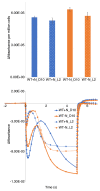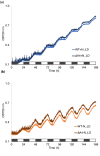Photosynthetic modulation during the diurnal cycle in a unicellular diazotrophic cyanobacterium grown under nitrogen-replete and nitrogen-fixing conditions
- PMID: 36344535
- PMCID: PMC9640542
- DOI: 10.1038/s41598-022-21829-6
Photosynthetic modulation during the diurnal cycle in a unicellular diazotrophic cyanobacterium grown under nitrogen-replete and nitrogen-fixing conditions
Abstract
Cyanobacteria are the only oxygenic photosynthetic organisms that can fix nitrogen. In diazotrophic cyanobacteria, the regulation of photosynthesis during the diurnal cycle is hypothesized to be linked with nitrogen fixation and involve the D1 protein isoform PsbA4. The amount of bioavailable nitrogen has a major impact on productivity in aqueous environments. In contrast to low- or nitrogen-fixing (-N) conditions, little data on photosynthetic regulation under nitrogen-replete (+ N) conditions are available. We compared the regulation of photosynthesis under -N and + N conditions during the diurnal cycle in wild type and a psbA4 deletion strain of the unicellular diazotrophic cyanobacterium Cyanothece sp. ATCC 51142. We observed common changes to light harvesting and photosynthetic electron transport during the dark in + N and -N conditions and found that these modifications occur in both diazotrophic and non-diazotrophic cyanobacteria. Nitrogen availability increased PSII titer when cells transitioned from dark to light and promoted growth. Under -N conditions, deletion of PsbA4 modified charge recombination in dark and regulation of PSII titer during dark to light transition. We conclude that darkness impacts the acceptor-side modifications to PSII and photosynthetic electron transport in cyanobacteria independently of the nitrogen-fixing status and the presence of PsbA4.
© 2022. The Author(s).
Conflict of interest statement
The authors declare no competing interests.
Figures






Similar articles
-
Enhanced Nitrogen Fixation in a glgX-Deficient Strain of Cyanothece sp. Strain ATCC 51142, a Unicellular Nitrogen-Fixing Cyanobacterium.Appl Environ Microbiol. 2019 Mar 22;85(7):e02887-18. doi: 10.1128/AEM.02887-18. Print 2019 Apr 1. Appl Environ Microbiol. 2019. PMID: 30709817 Free PMC article.
-
Transcriptional and translational regulation of photosystem I and II genes in light-dark- and continuous-light-grown cultures of the unicellular cyanobacterium Cyanothece sp. strain ATCC 51142.J Bacteriol. 1998 Feb;180(3):519-26. doi: 10.1128/JB.180.3.519-526.1998. J Bacteriol. 1998. PMID: 9457853 Free PMC article.
-
Coupling of Cellular Processes and Their Coordinated Oscillations under Continuous Light in Cyanothece sp. ATCC 51142, a Diazotrophic Unicellular Cyanobacterium.PLoS One. 2015 May 14;10(5):e0125148. doi: 10.1371/journal.pone.0125148. eCollection 2015. PLoS One. 2015. PMID: 25973856 Free PMC article.
-
Protein turnover and plant RNA and phosphorus requirements in relation to nitrogen fixation.Plant Sci. 2012 Jun;188-189:25-35. doi: 10.1016/j.plantsci.2012.02.010. Epub 2012 Feb 25. Plant Sci. 2012. PMID: 22525241 Review.
-
Nitrogen fixation and photosynthetic oxygen evolution in cyanobacteria.Res Microbiol. 2003 Apr;154(3):157-64. doi: 10.1016/S0923-2508(03)00029-9. Res Microbiol. 2003. PMID: 12706503 Review.
References
Publication types
MeSH terms
Substances
Grants and funding
LinkOut - more resources
Full Text Sources

